Luana Perilli
23.09.2014 – 22.11.2014
Exhibition Views

Hanging Lava, 2014, glazed ceramics, kokedama monstera, macramè, various dimensions, photo by Giorgio Benni 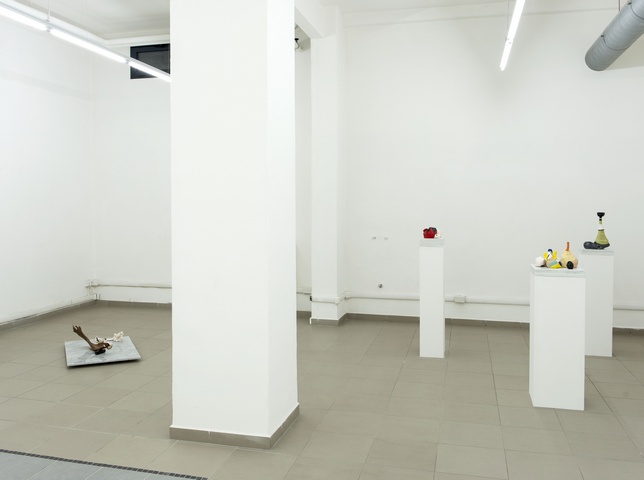
Solitary Shelters, installation view at The Gallery Apart (basement), Rome, photo by Giorgio Benni 
Solitary Shelters, installation view at The Gallery Apart (basement), Rome, photo by Giorgio Benni 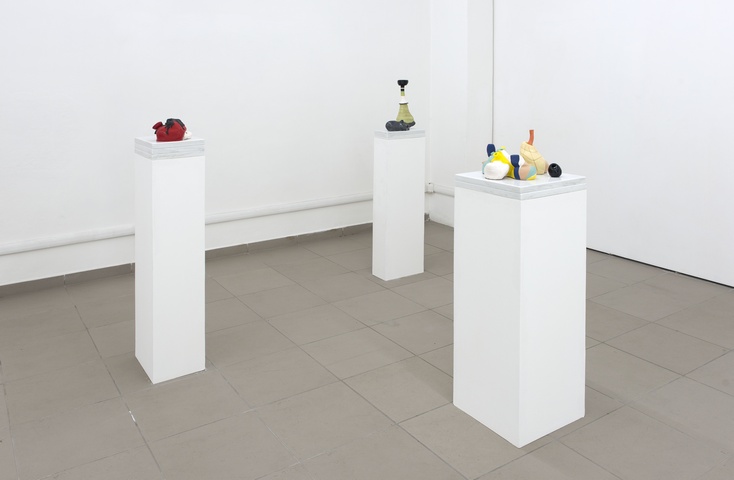
Solitary Shelters, installation view at The Gallery Apart (basement), Rome, photo by Giorgio Benni 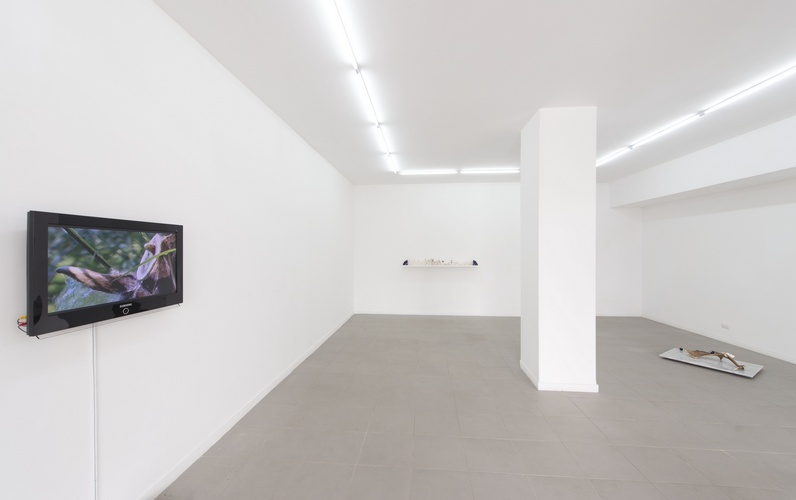
Solitary Shelters, installation view at The Gallery Apart (ground floor), Rome, photo by Giorgio Benni
Works

Hanging Lava, 2014, glazed ceramics, kokedama monstera, macramè, various dimensions, (detail) 
Hanging Lava, 2014, glazed ceramics, kokedama monstera, macramè, various dimensions, (detail) 
Hanging Lava, 2014, glazed ceramics, kokedama monstera, macramè, various dimensions, (detail), photo by Giorgio Benni 
Urfomen, 2014, video, 00:06:50, photo by Giorgio Benni 
Urfomen, 2014, video, 00:06:50 
Unglazed Shelf, 2014, agate gemstones, ceramics, cm 20 x 180 x 20, photo by Giorgio Benni 
Unglazed Shelf, 2014, agate gemstones, ceramics, cm 20 x 180 x 20, (detail) 
Horn Nest#1, 2014, Carrara marble, glazed ceramic, antler, agate gemstones, cm 90 x 60 x 18 
Horn Nest#2, 2014, Carrara marble, glazed ceramics, antler, cm 92 x 65 x 26,5, photo by Giorgio Benni 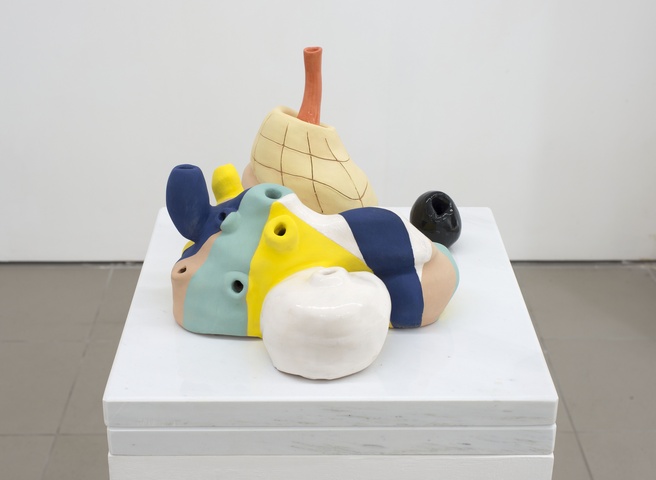
Konvolut #1, 2014, Carrara marble, glazed ceramics, wooden plinth, cm 35 x 35 x 127, photo by Giorgio Benni 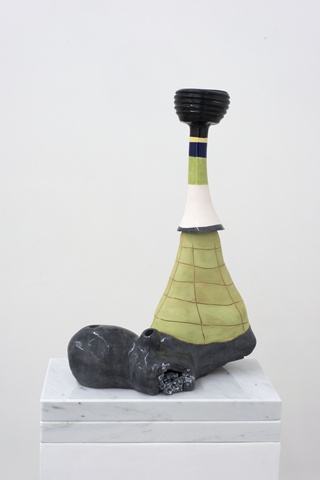
Konvolut #2, 2014, Carrara marble, glazed ceramics, wooden plinth, cm 30 x 15 x 147, photo by Giorgio Benni 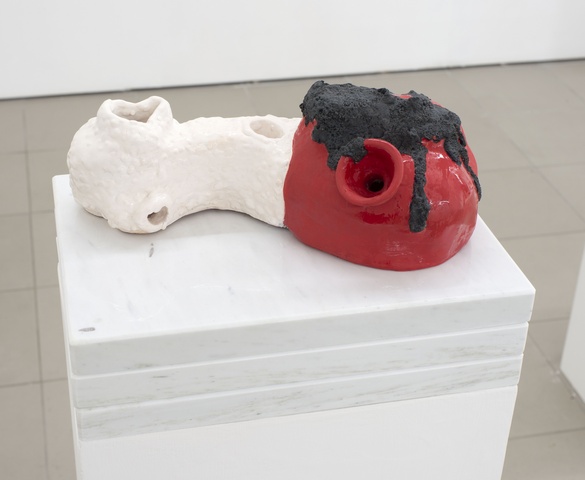
Konvolut #3, 2014, Carrara marble, glazed ceramics, wooden plinth, cm 32 x 23 x 130, photo by Giorgio Benni 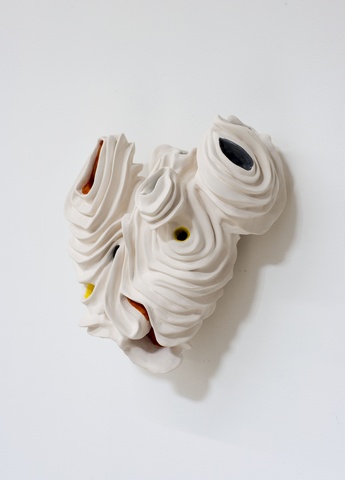
Op-Nest, 2014, glazed ceramics, cm 27 x 29 x 15, photo by Giorgio Benni
The Gallery Apart is proud to open its new 2014/2015 season with the exhibition Solitary Shelters, the third solo show by Luana Perilli hosted in our gallery. Although the artist’s exploration, this time focused on the relationships between nature and culture, or rather between ideology and ecology, highlights a common thread running through the work carried out over the last few years based on the eusocial animals and the relationships of their social structures with the human societies, the means chosen for this new series of works departs from the previous production and focuses on ceramic sculpture, chosen as an artistic expression hinged on an ancient and intercultural language, compatible with the natural habitats. The typologies and forms, selected, imagined, drawn and personally shaped and sculpted by the artist using the potter’s wheel, create structures that may have the double function of sculptures and of Shelters or nest for the pollinating insects, combining both the ethical and aesthetic functions within the same object. The link between the natural and artifactual world in virtue of the human presence and action in this case is inspired to a particular design style, the organic modern, which drew on the concept of organic architecture introduced by Frank Lloyd Wright in the late 1940s and which has inspired several architects who, over the following decades, have delivered new and brilliant interpretations, such as the renowned Buckminster Fuller. Perilli has then taken as a model elements of design inspired to nature by delving into the German art pottery from the 1950s and 1960s, in particular those by Sgrafo, Fat Lava and Rosenthal, making the formal suggestion an element that nature can actually embrace.
The reference to the furniture item, which is so recurring in the artist’s poetics, serves both as an evocative factor of a bourgeois lifestyle able to recall values and lifestyles so invasive in their heyday as ephemeral in a historical perspective, and as a prompt to present new combinations of forms and materials. The sculptures thus merge and integrate in the ceramics other natural elements which are typical of the modern, such as the agate gemstones and some plants.
The Gallery Apart è orgogliosa di inaugurare la stagione 2014/2015 con la mostra Solitary Shelters, terza personale di Luana Perilli in galleria. Se la ricerca dell’artista, questa volta incentrata sui rapporti tra natura e cultura, o meglio tra ideologia ed ecologia, attesta una continuità tematica rispetto al lavoro condotto negli anni scorsi intorno agli animali eusociali e alle relazioni dei loro modelli comunitari con le società umane, il mezzo prescelto per il nuovo ciclo di opere si distacca dalla precedente produzione per concentrarsi sulla scultura in ceramica scelta come modalità espressiva fondata su un linguaggio antico e interculturale, compatibile con gli habitat naturali. Le tipologie e le forme, selezionate, immaginate, disegnate e personalmente realizzate al tornio dall’artista, danno vita a strutture che possono avere la doppia funzione di sculture e di rifugi o nidi per insetti impollinatori in una convivenza di funzioni etiche ed estetiche all’interno dello stesso oggetto.
Il collegamento tra universo naturale e mondo artefatto in virtù della presenza e dell’attività dell’uomo è in questo caso affidato all’ispirazione ad un preciso filone di design, quello stile organic modern che riprese la lezione e la nozione di architettura organica che Frank Lloyd Wright introdusse negli anni 40 e che ha ispirato molti architetti che nei decenni seguenti fornirono nuove e geniali interpretazioni, primo fra tutti Buckminster Fuller. Perilli ha così assunto a modello elementi di design ispirati alla natura studiando approfonditamente le ceramiche tedesche degli anni 50 e 60, in particolare le ceramiche Sgrafo, Fat Lava e Rosenthal, rendendo il suggerimento formale un elemento di cui la natura possa effettivamente appropriarsi.
Il riferimento all’elemento d’arredo, ricorrente nella poetica dell’artista, si afferma sia come fattore evocativo di un quotidiano borghese in grado di richiamare alla memoria valori e stili di vita tanto invasivi all’epoca del loro fulgore quanto effimeri in un’ottica di prospettiva storica, sia come spunto per riproporre forme e materiali in nuove combinazioni. In tal senso le sculture associano e integrano nella ceramica altri elementi naturali tipici del moderno come le pietre d’agata e alcuni vegetali.
share on